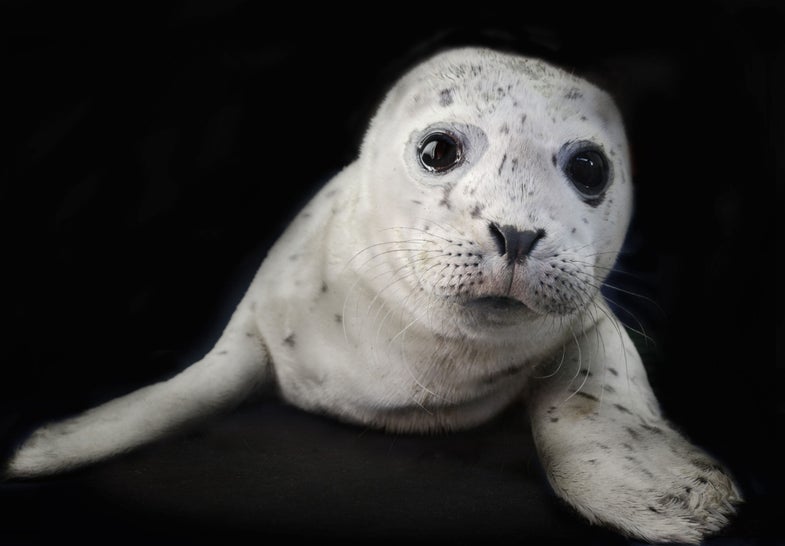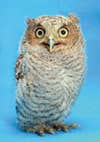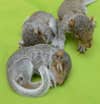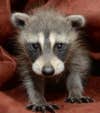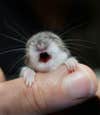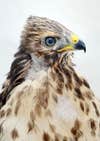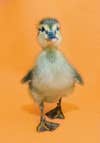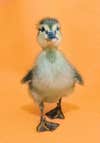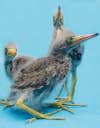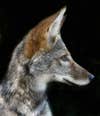Screech Owl, six weeks old
These tiny owls are smaller than a pint glass as adults. Screech owls are generally monogamous, mating for life. They nest in hollows of trees, and often recycle the nests of other animals. In the nest, screech owl hatchlings fiercely fight each other for food and resources, often killing the smaller, weaker siblings. From: Wild Babies: Photographs of Baby Animals from Giraffes to Hummingbirds by Traer Scott, published by Chronicle Books 2016.
About four years ago, photographer Traer Scott started working on her latest book, Wild Babies, devoted to documenting wild, orphaned baby animals.
The idea for the book was born two weeks after the birth of Scott’s own daughter. Scott was at a wedding when a friend ran up to her holding a baby squirrel that had just fallen out of a tree. “I’ve always had that instinct to say, ‘I’ll take care of it’,” Scott says. “It didn’t have very much fur and was very tiny.”
Harbor Seal, two weeks old
Harbor seals are long-lived, with lifespans reaching twenty-five to thirty years. During their lives, adult females can give birth to one pup every year. Harbor seal pups are able to swim at birth, but will often ride on their mother’s backs when they are tired. Pups form a strong bond with their mothers and are very vocal, making a bleating noise that sounds like “maaaa” to communicate with their mothers. From: Wild Babies: Photographs of Baby Animals from Giraffes to Hummingbirds by Traer Scott, published by Chronicle Books 2016.
Scott put the squirrel in a box and drove herself, her husband, the baby squirrel and her two-week-old baby home. When she got to the house, Scott says, she realized that she had no idea how to take care of a baby squirrel.
“So I Googled,” Scott says. “I found out they had to eat every two hours! I realized I wasn’t equipped to feed two infants ‘round the clock.”
Giraffe, five weeks old
A mother giraffe gives birth standing up, usually after a fifteen-month gestation period. The baby giraffe, or calf, is about 6 feet (1.8 meters) tall when born, often weighing up to 200 pounds (91 kilograms). Calves learn to walk within hours of being born, to avoid becoming prey to other mammals like lions and hyenas. From: Wild Babies: Photographs of Baby Animals from Giraffes to Hummingbirds by Traer Scott, published by Chronicle Books 2016.
That Saturday night, as Scott researched veterinarians and animal rescues that might be able to help her care for this injured squirrel, she came across Wildlife Rehabilitators Association of Rhode Island. On its website, Scott found a list of people who took care of all kinds of wild animals: everything from possums to baby birds. One woman adopted orphaned squirrels. Despite the late hour, she picked up the phone and to Scott’s surprise, the lady answered.
Eastern Gray Squirrel, four weeks old
Baby squirrels are called “kittens.” Kittens are born twice a year, once in the springtime and once at the end of the summer. These four-week-old baby squirrels will not be ready to be re-released into the wild until twelve weeks of age. From: Wild Babies: Photographs of Baby Animals from Giraffes to Hummingbirds by Traer Scott, published by Chronicle Books 2016.
During all the commotion, Scott realized the squirrel wasn’t moving very much so she put it on a heating pad. “The animal was dying,” Scott says. “I gave the baby to my husband and put the squirrel in a box and drove to this woman’s house. I handed the squirrel to the wonderful woman who answered her phone at 10 p.m. on a Saturday night.”
Raccoon, four weeks old
Baby raccoon pups are very social, often bonding with and playing with other pups. Raccoons are instinctively curious and intelligent, with remarkably agile, human-like hands that enable them to perform highly dexterous tasks like opening gates and washing pieces of fruit. Raccoons are very prominent in both rural and urban areas of North America, where they are often viewed as pests. From: Wild Babies: Photographs of Baby Animals from Giraffes to Hummingbirds by Traer Scott, published by Chronicle Books 2016.
That night, back home with her own baby, Scott came up with the idea for her next project. In the end, she included more than 30 species of orphaned animals in the book, which took about three years to shoot.
White-Footed Mouse, two weeks old
A female field mouse is able to mate two to four times a year and, after a short gestation period, give birth to up to nine babies, which are blind, pink, and completely hairless at birth. These “pinkies,” which are usually only a few centimeters long, will be completely weaned and able to leave the nest just twenty-one days after birth, and females can have their first litter at the age of thirteen weeks. From: Wild Babies: Photographs of Baby Animals from Giraffes to Hummingbirds by Traer Scott, published by Chronicle Books 2016.
“Babies only come through for a short period of time,” Scott says. “Baby season is short—spring to late summer. I needed three seasons to get several creatures in the book.”
One of the challenges with photographing wild babies, Scott says, presented itself when she realized she had no idea which species were going to be born when. “For the years I was shooting, I was nervous that I’d be able to find enough subjects within the constraints of the deadlines,” she says. “I shot within the peak of baby season and then wouldn’t shoot for six months.”
Red-Shouldered Hawk, three weeks old
Red-shouldered hawks build large nests out of sticks in the forks of trees. These nests are often refreshed annually and used year after year. Hatchlings leave the nest at about six weeks old, but remain with their parents and depend on them for food and protection for another couple of months. Only half of all red-shouldered hawks will survive their first year of life. Many fall victim to natural predation by other animals, human impact, or starvation. From: Wild Babies: Photographs of Baby Animals from Giraffes to Hummingbirds by Traer Scott, published by Chronicle Books 2016.
At the time, Scott wasn’t a stranger to photographing wild animals. She had previously documented wild nocturnal animals for her book Nocturne. But the style that emerged in Wild Babies evolved over several “baby seasons,” and there was a lot of trial and error in getting the hang of shooting mostly small, wild animals, she says.
Red Kangaroo, four months old
Kangaroos are the world’s largest marsupials, but at birth are about the size of a cherry. Born blind, hairless, and less than an inch (only a few centimeters) long, the joey immediately climbs into the mother’s pouch to nurse, and remains there for up to six months. The joey will spend a few weeks just poking its head out of the pouch, and then progress to spending increasingly more time in the outside world. It won’t be until almost a full year after birth that the young kangaroo will leave the pouch for good. From: Wild Babies: Photographs of Baby Animals from Giraffes to Hummingbirds by Traer Scott, published by Chronicle Books 2016.
“[The animals are] not social,” Scott says. “It’s very different than working with, dogs, for example. The learning curve was sharp, but I had dealt with [some of the same challenges] with making Nocturne. A possum is going to instinctually be terrified if you’re anywhere near it.”
Red Fox, eight weeks old
Red fox kits are born blind, deaf, and unable to regulate their own body temperature. The mother stays with her kits twenty-four hours a day for up to three weeks after giving birth, during which time the kits’ father or another female from the family will feed the mother. Females from the litter will often stay with the family to help with the next year’s litter, while males will leave the family as juveniles to go and start their own families. From: Wild Babies: Photographs of Baby Animals from Giraffes to Hummingbirds by Traer Scott, published by Chronicle Books 2016.
For Nocturne, Scott had to come up with a style of photographing that kept the terrified critters safe, but still allowed her to shoot in a mock studio setting, which often was a small space in a wildlife rehab facility. Her husband Jesse Blair came up with a foam core black box with a hole cut out that she could stick a camera lens through.
Painted Turtle, less than one year old
Painted turtles are cold-blooded and therefore regulate their body temperature via their environment. They often gather in groups, basking in the sun for warmth. When cold weather comes, the painted turtle burrows under the ground or under a body of water and hibernates until spring. While in hibernation, their body temperature stays at about 43° Fahrenheit (6° Celsius) and they do not breathe—they’re able to survive very long periods without oxygen. Painted turtles shed pieces of their shells as they grow bigger. Turtle shells are made of bone covered by separate sections of keratin called scutes. As a young turtle grows, new layers of scutes will form, eventually causing the old ones to peel off. From: Wild Babies: Photographs of Baby Animals from Giraffes to Hummingbirds by Traer Scott, published by Chronicle Books 2016.
That box gave the animals a way to be themselves, she says. “They’re not as fearful in the box and can’t escape,” she says. “After a few minutes they would relax and start exploring, making it possible to get more candid shots.”
Opossums, four weeks old
These highly common marsupials are often as small as bees when they are born and will spend at least seventy days in their mother’s pouch before emerging on their own. For the next month or so after leaving the pouch, the babies will spend most of their time clinging to their mother’s back while she roams and forages for food. Opossums have what are called prehensile tails, which means that their tails can wrap around things and hold them. These long, hairless tails enable baby opossums to climb and hang from trees without falling, but young opossums will not actually sleep hanging upside down until they are adults. From: Wild Babies: Photographs of Baby Animals from Giraffes to Hummingbirds by Traer Scott, published by Chronicle Books 2016.
As props for the babies, she tried out items she found around the clinic like towels, fleece pouches and sometimes someone’s hand. But these didn’t produce the look Scott was going for. Eventually she adapted the Nocturne box, adding colorful felt as the backdrop for the studio-style baby animal portraits.
Mallard Duckling, one week old
When a duckling hatches it will imprint upon the first living creature it sees that is larger than itself, which is usually the mother duck. Ducklings are able to walk and swim just hours after hatching, but will stay with their mothers and siblings, often parading in a line when walking and swimming, for a few weeks. Ducklings usually take their first flight at about two months old. From: Wild Babies: Photographs of Baby Animals from Giraffes to Hummingbirds by Traer Scott, published by Chronicle Books 2016.
Mallard Duckling, one week old
When a duckling hatches it will imprint upon the first living creature it sees that is larger than itself, which is usually the mother duck. Ducklings are able to walk and swim just hours after hatching, but will stay with their mothers and siblings, often parading in a line when walking and swimming, for a few weeks. Ducklings usually take their first flight at about two months old. From: Wild Babies: Photographs of Baby Animals from Giraffes to Hummingbirds by Traer Scott, published by Chronicle Books 2016.
“The need developed the box, and the style developed because of the box,” Scott says. “I needed a way to photograph the animals, and the shooting style was shaped by the box.”
Green Heron, three weeks old
Green herons are one of the few species of bird that builds and uses tools. They create fishing lures out of twigs, crusts of bread, feathers, or other detritus, which they then dip in the water to entice fish to the surface. Green herons are seasonally monogamous, and perform elaborate courtship displays to attract a mate. This behavior often includes calling, snapping their bills, and craning their necks. Once pairing and mating have occurred, both parents help incubate and feed the hatchlings, which will remain with their parents until they are about one month old. From: Wild Babies: Photographs of Baby Animals from Giraffes to Hummingbirds by Traer Scott, published by Chronicle Books 2016.
“Wild Babies is cute and sweet,” Scott says. “But a lot of these animals are orphans that wouldn’t have survived on their own but for the intervention of these private people, wildlife rehabs and clinics that help them recover all while raising them by hand.”
Wild Babies, from Chronicle Books, is out now.
Coyote, eight weeks old
Coyotes live in nuclear families within a larger pack structure. During breeding season, they make their dens in rocky crevices, hollow trees, and shrubbery. When babies are born, both the mother and father help to care for the pups. Sometimes older siblings will also help. After the pups are weaned, the family abandons the den, but may come back to use it again the following year. Coyote pups are considered mature at about nine months, at which time some will leave home while others will continue to live with the pack. From: Wild Babies: Photographs of Baby Animals from Giraffes to Hummingbirds by Traer Scott, published by Chronicle Books 2016.
Cottontails, ten days old
A mother rabbit’s milk is so nutrient-rich that baby rabbits—also known as kits or kittens—only need to nurse once every twenty-four hours, usually at night. The mother rabbit does not stay with the nest during the day, as her presence may attract predators, so generally the babies are covered with leaves or grass until Mom returns. From: Wild Babies: Photographs of Baby Animals from Giraffes to Hummingbirds by Traer Scott, published by Chronicle Books 2016.
